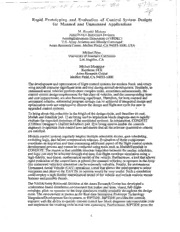
NASA Technical Reports Server (NTRS) 20000094038: Rapid Prototyping and Evaluation of Control System Designs for Manned and Unmanned Applications PDF
Preview NASA Technical Reports Server (NTRS) 20000094038: Rapid Prototyping and Evaluation of Control System Designs for Manned and Unmanned Applications
Rapid Prototyping and Evaluation of Control System Designs for Manned and Unmanned Applications M. Hossein Mansur ArmyNASA Rotorcraft Division Aeroflightdynarnics Directorate (AVRDEC) U.S. Army Aviation and Missile Command Ames Research Center, Moffett Field, CA 94035-1000, USA Michael Frye University of Southern California Los Angeles, CA Michael Montegut Raytheon STX Ames Research Center Moffett Field, CA 94035-1000 The development and optimization of flight control systems for modern fixed- and rotary- wing aircraft consume significant time and cost during aircraft development. Similarly, as unmanned aerial vehicles perform more complex tasks, sometimes autonomously, the control system design requirements for this class of vehicles, and the corresponding time and cost requirements, are also becoming significant. Therefore, for both manned and unmanned vehicles, substantial program savings can be achieved if integrated design and optimization tools are employed to shorten the design and flight-test cycle for new or upgraded ,control systems. i To bring about this reduction in the length of the design-cycle, and therefore its cost, Matlab and Simulink [ref. 11 are being used to implement block diagrams and to rapidly evaluate the expected responses of the completed systems. In conjunction, CONDUIT (CONtrol Designer's Unified InTerface) [ref. 21 is being used to enable the controls engineers to optimize their control laws and ensure that all the relevant quantitative criteria are satisfied. Modem control systems regularly employ multiple selectable modes, gain scheduling, switching logic, and failure compensation schemes. Evaluation of these components constitutes an important and time-consuming additional aspect of the flight control system development process and cannot be conducted using tools such as MatlablSimulink or CONDUIT. The reason is that credible dynamic transition between the modes, schedules, and logic can only be achieved through real time, full-flight-envelope simulation using a high-fidelity, non-linear, mathematical model of the vehicle. Furthermore, a tool that allows rapid evaluation of the control laws in piloted (for manned vehicles) or operator-in-the-loop (for unmanned vehicles) simulation can be extremely valuable. Finally, for autonomous Unmanned Aerial Vehicle (UAV) operations, a tool that allows the userloperator to select waypoints and observe the UAV fly its mission would be very useful. Such a simulation could employ a high-fidelity mathematical model of the vehicle and include realistic terrain features and possible threats. The NASAlArmy Rotorcraft Division at the Ames Research Center has developed a workstation-based simulation environment that makes real time, visual, full-flight- envelope, pilot- or operator-in-the-loop simulation readily available throughout the design cycle. The environment is known as the Real-time Interactive Prototype Technology Integration/Development Environment, or RIPTIDE. RIPTIDE provides the controls engineer with the ability to quickly convert control law block diagrams into executable code and implement the resulting code in real time simulation. Furthermore, RTPTIDE gives the controls engineer the ability to interactively change block diagram parameters in red time and observe the modified response. The simulation can include a pilot (for manned vehicles) or an operator (for unmanned vehicles) in the loop so that pilot/operator opinion can be gathered early in the design cycle. The core RIPTIDE environment consists of a suite of software modules that schedule the various simulation processes in real time and provide for communication between them through shared memory. RIPTIDE employs an open and modular software architecture that allows any module to be added or modified without a need to modify the rest of the simulation environment. The RIPTIDE main Graphical User Interface (GUI) (figure 1) enables the user to setup a simulation by selecting a math model, a control system, a set of inceptors, a graphical database, and any other processes needed for the particular simulation from a list of available options. RIF'TIDE strongly complements MatlabfSimulink and CONDUIT control system development tools. Control system block diagrams developed in MatlablSimulink and optimized in CONDUIT can be implemented in the RIPTIDE environment in a matter of minutes and evaluated. Changes can be made in real time and the control system re- evaluated until an acceptable design is reached. If the control laws were originally optimized in CONDUIT, they can be returned to CONDUIT and evaluated to ensure that the new changes do not adversely affect satisfaction of any design criteria. Through this connectivity, MatlabISimulink, CONDUIT, and RIPTIDE constitute an integrated set of design tools that can significantly shorten the control system design cycle. The paper will describe the RIPTIDE simulation environment in detail, including the scene and instrument display capabilities (figure 2), pilot/operator controller and simulation environment (figure 3), and math model~controlla w integration process. The applicability of RIPTIQE to the rapid evaluation of control system designs in real time, full-flight- envelope, simulation will be demonstrated. As an example, the development of a mathematical model for a Yarnaha R-50 UAV, the implementation of this math model within the RIPTIDE environment, and the evaluation of control laws (developed as part of a separate effort conducted by Carnegie Mellon University) for autonomous control of this vehicle will be described and results presented. A short video will be presented to better demonstrate the graphical capabilities of the system and the level of realism achievable. References 1. MATLAB: High-Performance Numeric Computation and Visualization Software. The Math Works, Inc., Reference Guide, 1992. 2. Tischler, M. B., Colbourne, J. D., Morel M. R., Biezad, D. J., Levine, W. S., and Moldoveanu, V., "CONDUIT - A new Multidisciplinary Integration Environment for Flight Control Development," AIAA Paper 97-3773, August 1997. Figure 2: RIPTIDE out-the-window graphics and GUI 3
